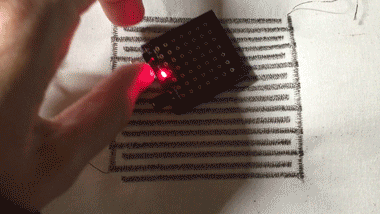Last week I was at the 2017 ACM CHI conference in Denver. The conference covered human-computer interaction topics ranging from accessibility, to education, to new hardware and materials for interacting with computers. When it comes to analyzing what people are doing with input devices, machine learning turned up more often than not. People presented all kinds of outputs including computer-printed food, timed release of perfumes, focused sound waves, and wearables that produce tiny electric currents to actually move your muscles. Interesting news if you’re growing tired of tapping on a keyboard and staring at a screen. It’s time to ponder how we will connect computers to soft, wearable circuits that are not guaranteed to maintain a constant shape, and come up with techniques that let people join and repair the soft electronic materials emerging from labs. Presentation slides are on Slideshare:
(Notes, image credits and references show up if you follow the link)
Here is the associated conference paper:
1525082
8K772Z2E
items
1
chicago-author-date
0
default
asc
1
961
https://harnettlab.org/wp-content/plugins/zotpress/
%7B%22status%22%3A%22success%22%2C%22updateneeded%22%3Afalse%2C%22instance%22%3A%22zotpress-48118dc5057c6df73620f32ec77eebcd%22%2C%22meta%22%3A%7B%22request_last%22%3A0%2C%22request_next%22%3A0%2C%22used_cache%22%3Atrue%7D%2C%22data%22%3A%5B%7B%22key%22%3A%228K772Z2E%22%2C%22library%22%3A%7B%22id%22%3A1525082%7D%2C%22meta%22%3A%7B%22creatorSummary%22%3A%22Harnett%22%2C%22parsedDate%22%3A%222017-05-09%22%2C%22numChildren%22%3A0%7D%2C%22bib%22%3A%22%3Cdiv%20class%3D%5C%22csl-bib-body%5C%22%20style%3D%5C%22line-height%3A%201.35%3B%20padding-left%3A%201em%3B%20text-indent%3A-1em%3B%5C%22%3E%5Cn%20%20%3Cdiv%20class%3D%5C%22csl-entry%5C%22%3EHarnett%2C%20C.%20K.%202017.%20%26%23x201C%3BTobiko%3A%20A%20Contact%20Array%20for%20Self-Configuring%2C%20Surface-Powered%20Sensors.%26%23x201D%3B%20In%20%3Ci%3EProceedings%20of%20the%202017%20CHI%20Conference%20on%20Human%20Factors%20in%20Computing%20Systems%3C%5C%2Fi%3E%2C%201%3A2024%26%23x2013%3B28.%20Denver%2C%20CO%3A%20ACM.%20%3Ca%20href%3D%27https%3A%5C%2F%5C%2Fdoi.org%5C%2F10.1145%5C%2F3025453.3025504%27%3Ehttps%3A%5C%2F%5C%2Fdoi.org%5C%2F10.1145%5C%2F3025453.3025504%3C%5C%2Fa%3E.%3C%5C%2Fdiv%3E%5Cn%3C%5C%2Fdiv%3E%22%2C%22data%22%3A%7B%22itemType%22%3A%22conferencePaper%22%2C%22title%22%3A%22Tobiko%3A%20A%20Contact%20Array%20for%20Self-Configuring%2C%20Surface-Powered%20Sensors%22%2C%22creators%22%3A%5B%7B%22creatorType%22%3A%22author%22%2C%22firstName%22%3A%22C.%20K.%22%2C%22lastName%22%3A%22Harnett%22%7D%5D%2C%22abstractNote%22%3A%22This%20paper%20describes%20a%20contact%20array%20that%20outputs%20the%20maximum%20and%20minimum%20voltages%20at%20its%20contacts.%20The%20goal%20is%20to%20extract%20power%20for%20a%20detachable%20touch%20sensor%2C%20display%2C%20or%20other%20human-computer%20interaction%20%28HCI%29%20device%20that%20is%20attached%20to%20a%20surface%20by%20a%20user%2C%20and%20that%20does%20not%20have%20its%20own%20power%20source.%20Experimental%20results%20are%20shown%20for%20an%20array%20that%20has%20positive%20and%20negative%20outputs%20and%20a%20pass-through%20at%20each%20contact%20position.%20It%20solves%20the%20startup%20problem%20for%20a%20randomly-placed%20batteryless%20sensor%20patch%20or%20sticker%2C%20which%20can%20scan%20its%20ports%20to%20discover%20neighboring%20devices%20only%20after%20it%20obtains%20power.%20Applications%20include%20user-configurable%20electronic%20textile%20circuits%2C%20and%20new%20methods%20for%20prototyping%20and%20repairing%20large-area%20flexible%20circuits.%20This%20note%20describes%20construction%20of%20a%207x7%20array%2C%20provides%20design%20rules%2C%20and%20examines%20the%20signal%20quality%20on%20two%20kinds%20of%20electronic%20surfaces.%22%2C%22date%22%3A%22May%209%2C%202017%22%2C%22proceedingsTitle%22%3A%22Proceedings%20of%20the%202017%20CHI%20Conference%20on%20Human%20Factors%20in%20Computing%20Systems%22%2C%22conferenceName%22%3A%22ACM%20CHI%20Conference%22%2C%22language%22%3A%22English%22%2C%22DOI%22%3A%2210.1145%5C%2F3025453.3025504%22%2C%22ISBN%22%3A%22%22%2C%22url%22%3A%22http%3A%5C%2F%5C%2Fdl.acm.org%5C%2Fcitation.cfm%3Fid%3D3025504%22%2C%22collections%22%3A%5B%22GXXIZJ7F%22%5D%2C%22dateModified%22%3A%222019-09-07T23%3A13%3A30Z%22%7D%2C%22image%22%3A%5B%22https%3A%5C%2F%5C%2Fharnettlab.org%5C%2Fwp-content%5C%2Fuploads%5C%2F2017%5C%2F05%5C%2FTobikoPlot.png%22%2C100%2C100%2Cfalse%5D%7D%5D%7D
Harnett, C. K. 2017. “Tobiko: A Contact Array for Self-Configuring, Surface-Powered Sensors.” In
Proceedings of the 2017 CHI Conference on Human Factors in Computing Systems, 1:2024–28. Denver, CO: ACM.
https://doi.org/10.1145/3025453.3025504.
